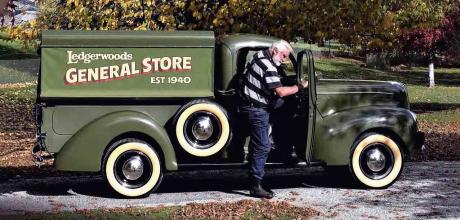1940 Ford V8 ½-Ton Pickup
Designed, originally for life on the farm, Ford’s pickups have become a worldwide style icon, and the coolest of them all are the mid-century survivors.
By Quinton Taylor
PICKING OVER THE PAST 1940 Ford V8 ½-Ton Pickup – WORKHORSE SURVIVOR
FORD PICKUP MID-CENTURY SURVIVOR
Ford cars from the years 1920 to 1949 provided the base for the new culture of hot-rodding thanks to the heart of every build, a V8 engine. Whether it was the flatheads or overhead ‘cammers’, other manufacturers simply had to follow suit. American life just wasn’t the same without a V8.
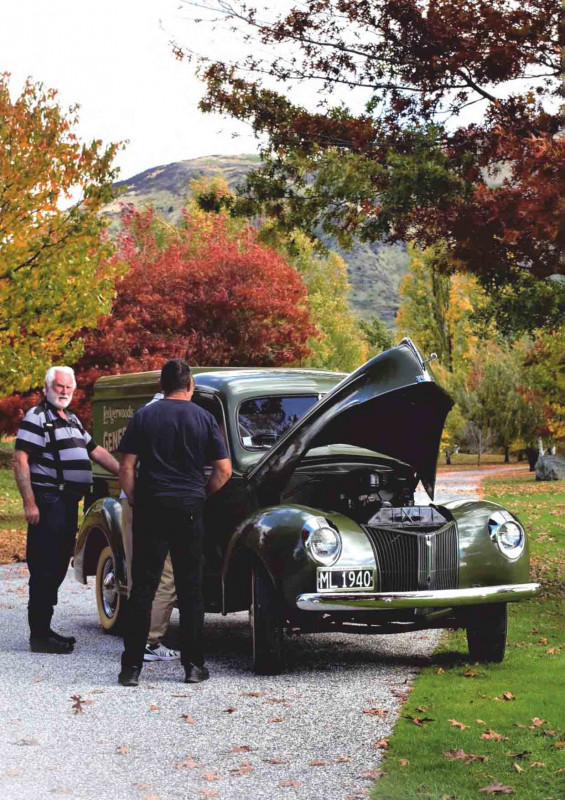
In those days, Ford’s trucking division provided another beachhead on its way to global domination. Henry Ford got the credit for inventing the production line, but when he saw farmers cutting and fitting flat-decks to Model Ts, he also went back to the drawing board and invented his own half-and-half vehicle, coining the term ‘pickup’.
Stylish and built to work hard, Ford’s pickups were light trucks with car-like driveability. They not only hit the top-seller spots but, over the decades, some have also become memorable collectables.
‘BUILT FORD TOUGH’
Sharing styling and component cues from contemporary Ford sedan models in the 1930–’40s, their appeal spread beyond the farm sector to a whole new breed of fan who appreciated their ability as a multi-use or lifestyle vehicle for the active family.
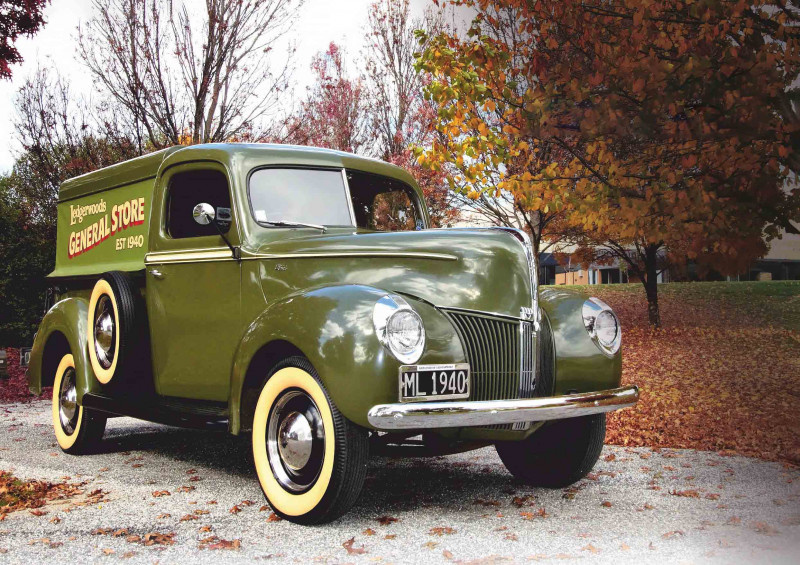
Ford’s marketing slogan ‘Built Ford Tough’, first used in 1979, captured the appeal of the pickup in the marketplace. Their popularity has only grown over time – the Ford pickup has been the best-selling ‘car’ in the US for the past 35 years.
Whether it is in the US, Europe, or New Zealand, it’s now cool to have one in your garage. As we approach 100 years of Ford pickups, that image and appeal are now stretching back to vehicles from the decades before the slogan was coined.
Jim and Daphne Ledgerwood have been around Fords most of their lives. They love their Ford coupes and two-door hardtops, while also making room for an occasional Chevrolet. Their Wānaka-based Originals collection – featured – is headed by an outstanding time-warp black 1940 Ford coup., its original factory assembly markings and documents offering something of a nostalgia trip.
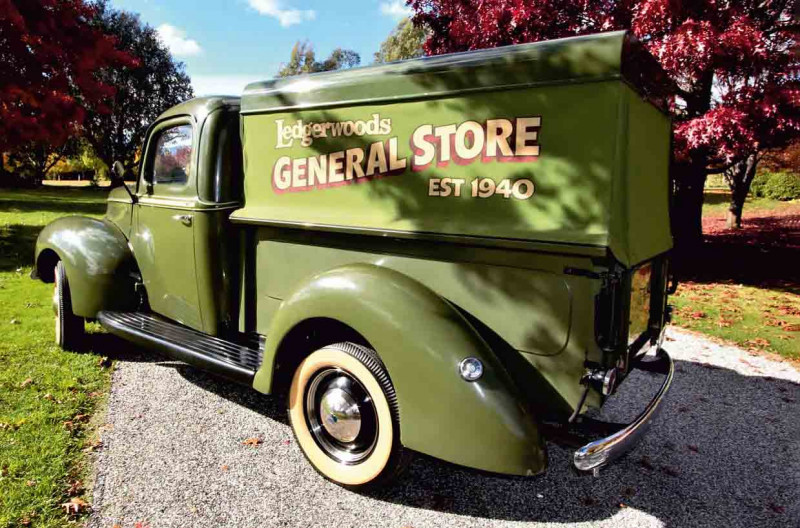
Jim’s early days in hot-rodding in Dunedin were spent building up a number of early Ford pickups, and he became a prolific builder of modified pickups.
“I had lots of early Ford V8s in those days,” he says, “and once I had finished them, I often sold them on. I would run out of garage space. I had up to a dozen restored Fords at most times then.”
A LIFE-LONG PASSION
Jim was a teenager when he began building his first pickup, a 1932 Ford B4 flat deck. Red with black mudguards, it shared garage space with a trendy cut-down 1934 Ford hot rod, in black, of course.
He remembers: “I bought ‘Hector’, a 1923 Ford B4 flat, off Viv Angow for $60 when I was 15. I also had a ’34 Ford hot rod, which I had built. I was 17 and had just restored Hector, and it was my intention to drive to Auckland in the ’34 to be there in time for the birth of my daughter.
“A friend crashed the ’34 two days before I was due to leave. I had to get to Auckland, so my friend and I drove Hector to Auckland. It was trouble-free except for when the muffler fell off on the Desert Road.”
Another project was a 1928 Ford Model A roadster that Jim painted black and turned into a pickup: “After many Fords, I came across a 1940 pickup in rough condition, but I did like the model. Over a couple of years, I restored both.”
The 1940 pickup was towed home from Timaru. A friend, Neville Mann, was called on to sign write the doors with “Ford Parts Dept, Dunedin” on the ’28. Jim bought his ’28 Model A from a hotel in Middlemarch that used it to cart barrels of beer from the train station back to the hotel.
The car now survives in the hands of Rex MacDonald at Outram. The 1940 was also painted black and sign written by Neville with “Ford Service Dept, Dunedin” to partner the ’28.
“Foolishly, I sold both,” says Jim. When we were compiling the coup. feature mentioned earlier, Jim and Daphne also had a few pickups scattered about and more were due to arrive, so an invitation to return and see the full display was eagerly acknowledged.
Wānaka turns on a brilliant sunny late afternoon when we line up the pickups with the help of neighbour and fellow pickup enthusiast David Reid along with a visiting friend, Dunedin engineer Roy Macdonald, who has turned up in a monster Ram pickup.
MORE ORIGINALS
Jim’s enthusiasm for Ford’s 1940 pickup is evident. A very well preserved dark green Ford, affectionately named ‘Ollie’, heads their impressive collection. Ollie is still looking great despite being restored in the late 1970s. It is one of many in their collection to have acquired a name. Ollie, among others, has featured occasionally as a wedding car and at shows.
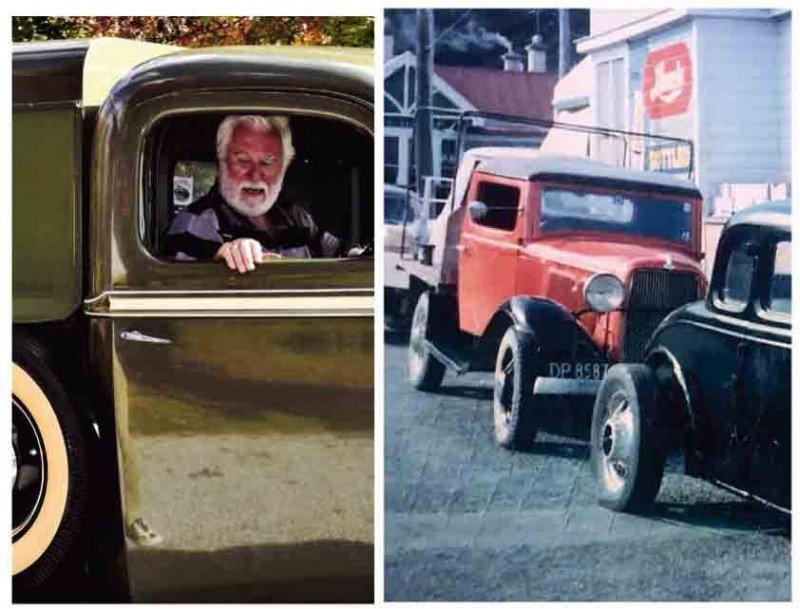
The popularity of pickups and restoring or ‘restomodding’ them has grown enormously in the US and it’s a trend gathering momentum here in New Zealand. Restomodding will usually involve engine and drivetrain upgrades, amazing paintwork, trim options, and even body fairing that can leave them far removed from their original condition when they left the Ford factory. Jim and Daphne’s collection bucks that trend, as all the pickups are stock standard.
Their collection of pickups, like their coupes and two-door hardtops, consists of well-looked after, low-mileage, and often one-owner original examples with a known history, mostly sourced from the States. Very little effort is needed to bring them up to pristine condition. All are runners, and the evolving collection is a great tribute to the couple’s drive and enthusiasm to preserve a bit of motoring history.
Ollie’s story is a little different, though, which makes him a bit special to Daphne and Jim.
OLLIE’S ORIGINS
It was in the late ’70s when Daphne and Jim spotted Ollie for the first time cruising the roads near Christchurch. It nearly made them late for their trip to the US, as Jim recalls: “Daph and I were heading to Christchurch to catch a flight to California to take part in an Early Ford V8 Club of America National Rally when I spotted Ollie travelling in the opposite direction. My immediate thought was to turn around and chase it and see if it could be bought. Daph reminded me that we were already running late and didn’t want to miss the flight.”
Jim was very keen to collect another 1940 Ford pickup and couldn’t get the thought of the local vehicle out of his mind. On their return, he contacted a friend, who, it turned out, knew the exact vehicle they had seen.
“I contacted the go-to man for early Ford V8s in the area, Gordon McKay, and of course Gordon knew the pickup,” Jim says. “He had repainted it, so he knew the owner, who was now living in Oamaru. Pretty soon, a deal was done, and Gordon took over the role of teaching my wife how to drive ‘Ollie’. It was her birthday present and still is very much part of the family.” Those hot-rodding days in Dunedin saw Jim develop a real enthusiasm for early Ford pickups and especially the 1940 models.
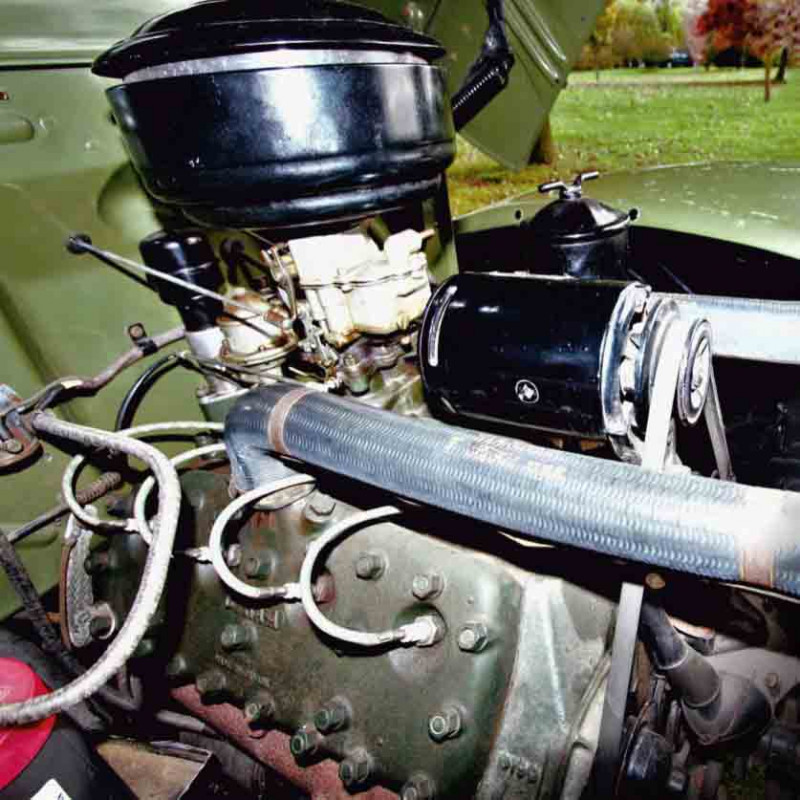
“I enjoyed pulling them to bits, rebuilding, repainting them, but I tended to lose interest when they were finished,” he says, “preferring to get on to the next project. I did enter many car shows and had good success and many were featured in car magazines.”
During the World War II in New Zealand, 1940 Ford pickups were rare. The New Zealand military used many of those that did arrive, and the fate of many of their old vehicles was to become used for target practice.
Farmers got hold of a few but not many ended up in private hands. “Once I reflected on how much I liked the 1940 model Ford pickup, I started looking for another,” Jim says. But with the chances of finding one locally being so slim, he looked to the States.
“Often when we were in the US, I used to admire 1940 sedan deliveries, but I accepted that with the limited visibility you have in a sedan delivery, driving a left-hand driver in New Zealand would be difficult,” he says.
With Ollie though, Jim knew that he might have a solution to his desire for a ‘delivery’ and set about tidying up the pickup and getting it into its current impressive state.
“I decided to build a canopy for Ollie to make her look much like a sedan delivery, but with the advantage that I could remove the canopy at any time and have a pickup again,” he says. “I wanted the canopy to be built in the style they would have used in 1940 of tin top and canvas sides. I entrusted that to a very skilled engineer, Barry Morgan, and when he and I had finished, I was very pleased with the result.”
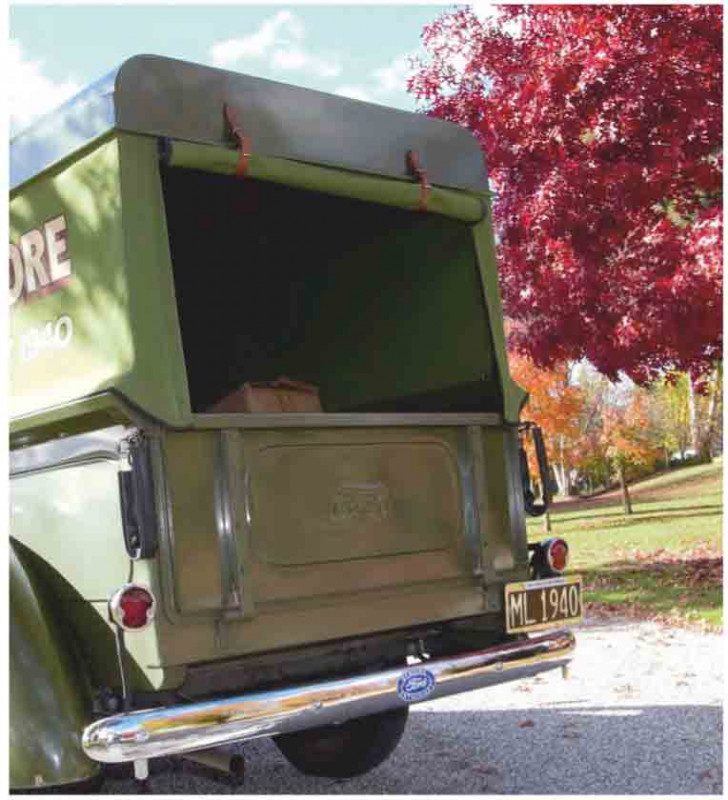
This all took place more than 50 years ago, back in the late 1970s, a time when there was nowhere near the range of techniques, paints, and materials that is available today. The look demanded signwriting, so Jim again sought the expertise of Neville Mann, who had painted his 1928 Ford Model A Roadster and the earlier 1940 pickup.
“Because of the canvas sides, it was going to be very difficult to achieve a top result by the traditional methods, so Neville spent many hours doing the signs by airbrushing them,” Jim explains. “It turned out perfectly, thanks to Neville’s skills, and it still looks so traditional to this day. As a result, I have left the canopy on but I know it’s just a 10-minute job to have Ollie looking like a Ford pickup again.”
The traditional method was to first coat the canvas in black paint and then add the writing. Neville thought this method would be a disaster. It would crack in no time in the hot Central Otago climate, and his approach has stood the test of time well.

The day we visit, Ollie sits gleaming in the late afternoon Central Otago sun and starts ‘on the button’ with that familiar side-valve V8 whirr. Jim drives it along the driveway, its engine purring very nicely for an 83-year-old workhorse. Ollie’s registration plate number also brings back memories of a friend’s 1940 Ford pickup that I helped restore back in the mid ’70s. It even had a plate similar to Ollie’s ‘HL1940’.
Jim has managed to secure a bit of documented history for Ollie too, to go with its original ownership papers. “It’s certainly one of our treasured ones,” he says. “We have had her for over 50 years, and it was always a very well-cared-for pickup. It belonged to Albert Wood, a brother of the Colonial Motors franchisee Robert Wood.”
The Ford dealership was in Hope Street, Dunedin while Albert was then a farmer in Weston, Oamaru. Jim has continued his theme of signwriting each of his pickups, drawing inspiration from when his parents ran a general store in the main street of Wānaka many years ago.
Ollie is also a special reminder to Jim of the first Ford pickup that he restored in Dunedin back when he was a teenager. He has regretted selling Hector ever since. As the years take their toll, Jim admits that working on his pickups is not as easy as it used to be. “Thank goodness I have Roy Macdonald and neighbour Dave Reid to help there,” he says. “It’s been a great deal of fun, and I’ve met some wonderful people through our interest in old Fords. I have continued to enjoy lovely old original, low owner, low miles Ford pickups.”
Ollie is also a special reminder to Jim of the first Ford pickup that he restored in Dunedin back when he was a teenager
“Gordon took over the role of teaching my wife how to drive ‘Ollie’. It was her birthday present and still is very much part of the family”
Neighbour David Reid’s Ford 150 heads a line-up of Jim and Daphne’s pickups
A STAR LINE-UP OF HAY CARTERS
Glowing in the afternoon sun, Jim and Daphne’s collection of pickups is impressive. 01: 1968 F100 Ranger 02: 1969 Ford F250 Camper Special 03: 1974 Ford F100 Explorer Limited Edition 04: 1977 Ford F100 Ranger XLT 05: 1974 Ford F100 fitted with a 5.9-litre V8 06: 1992 Ford F150 Supercab Flareside 07: 1928 Model A Pickup
LITTLE BIT OF HISTORY
Ever noticed how ornate that ‘Ford’ logo is pressed into the back tailgate of an early Ford pickup? Look carefully and you’ll see a noticeable lower case ‘e’ at the back of the curvy ‘F’ on the Ford name. The story goes that both Henry Ford and Thomas Edison had winter estates at Fort Myers, Florida. They shared ideas, along with a few cigars, and a thought which made Ford a legend in the automotive industry was the concept of ‘mass production’ on an assembly line, which would revolutionise the industry. The idea was Thomas’s, so Henry acknowledged this with that little lower case ‘e’ in the Ford name.
The popularity of pickups and restoring or ‘restomodding’ them has grown enormously
Jim has continued his theme of signwriting each of his pickups. Hector, the 1932 Ford B4 flat deck.
The first 1940 pickup Jim owned, rough but complete 1928 Ford Model A roadster becomes a pickup
The perfect finish is the side-mounted spare
TECHNICAL DATA FILE 1940 FORD V8 ½-TON PICKUP
- Production 1937–1940
- Engine V8 cast-iron monobloc with cast-iron flat cylinder head
- Capacity 3622cc (221cu in)
- Bore/Stroke Three-cubic-inch (ci) / 3.8ci (76mm/95mm)
- Comp. ratio 6.15:1
- Valves Side, two (in block) per cylinder with central-mounted camshaft in block
- Max Power 85bhp (62.56kW) at 3800rpm
- Max Torque 155-foot-pound (210Nm) at 2200rpm
- Transmission Three-speed manual
- Wheels 16x6-inch
- Dimensions:
- Wheelbase 2844.8mm
- Length 4667mm
- Height 1815mm
- Width 1832mm
- Deck length (well-side) 1974mm
- Weight 1347.2kg
Canvas roll-up still in great shape.
Left: Ford’s flat-head V8, with its bang-for-buck performance, was unlike anything else the world had ever seen at the time of its launch
In those days, Ford’s trucking division provided another beachhead on its way to global domination


